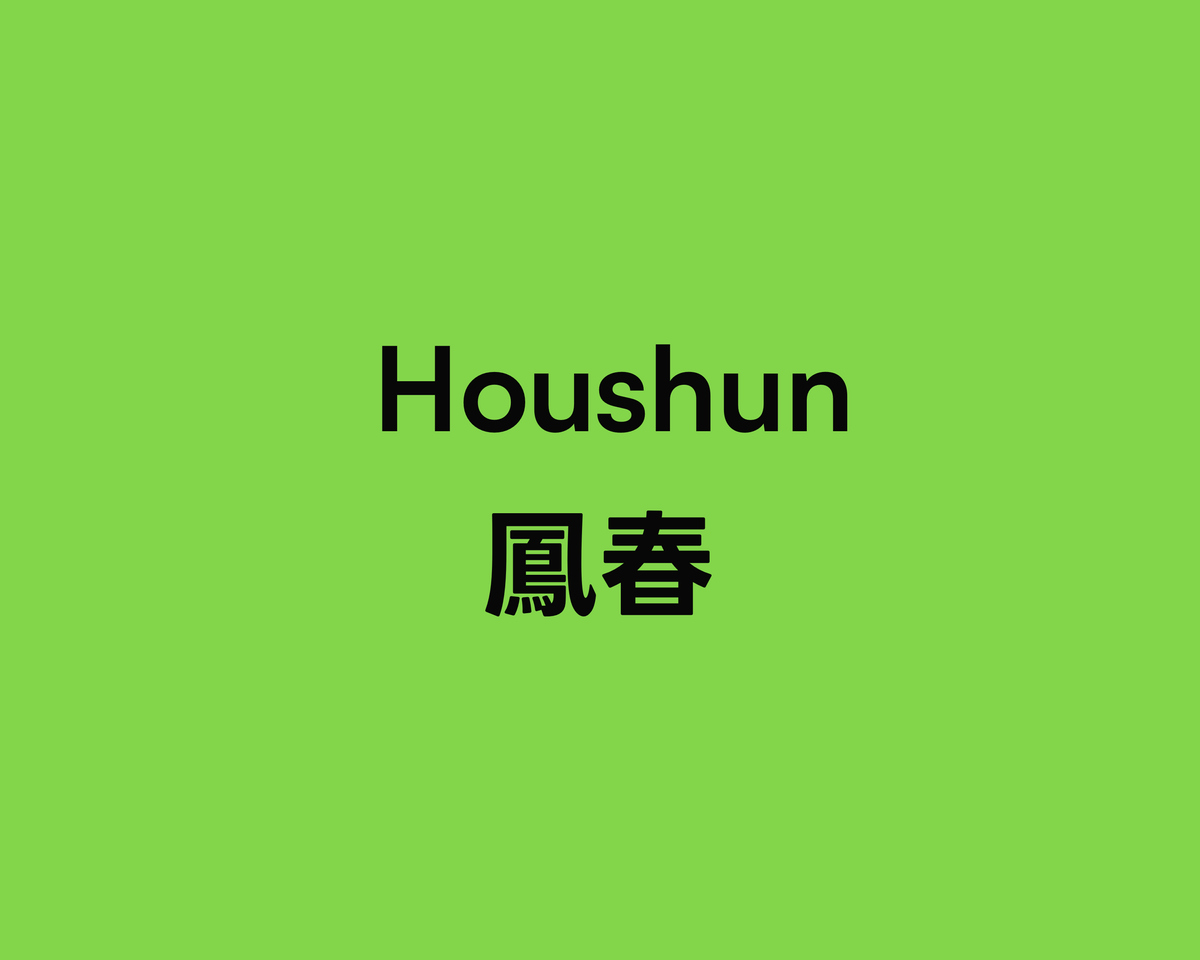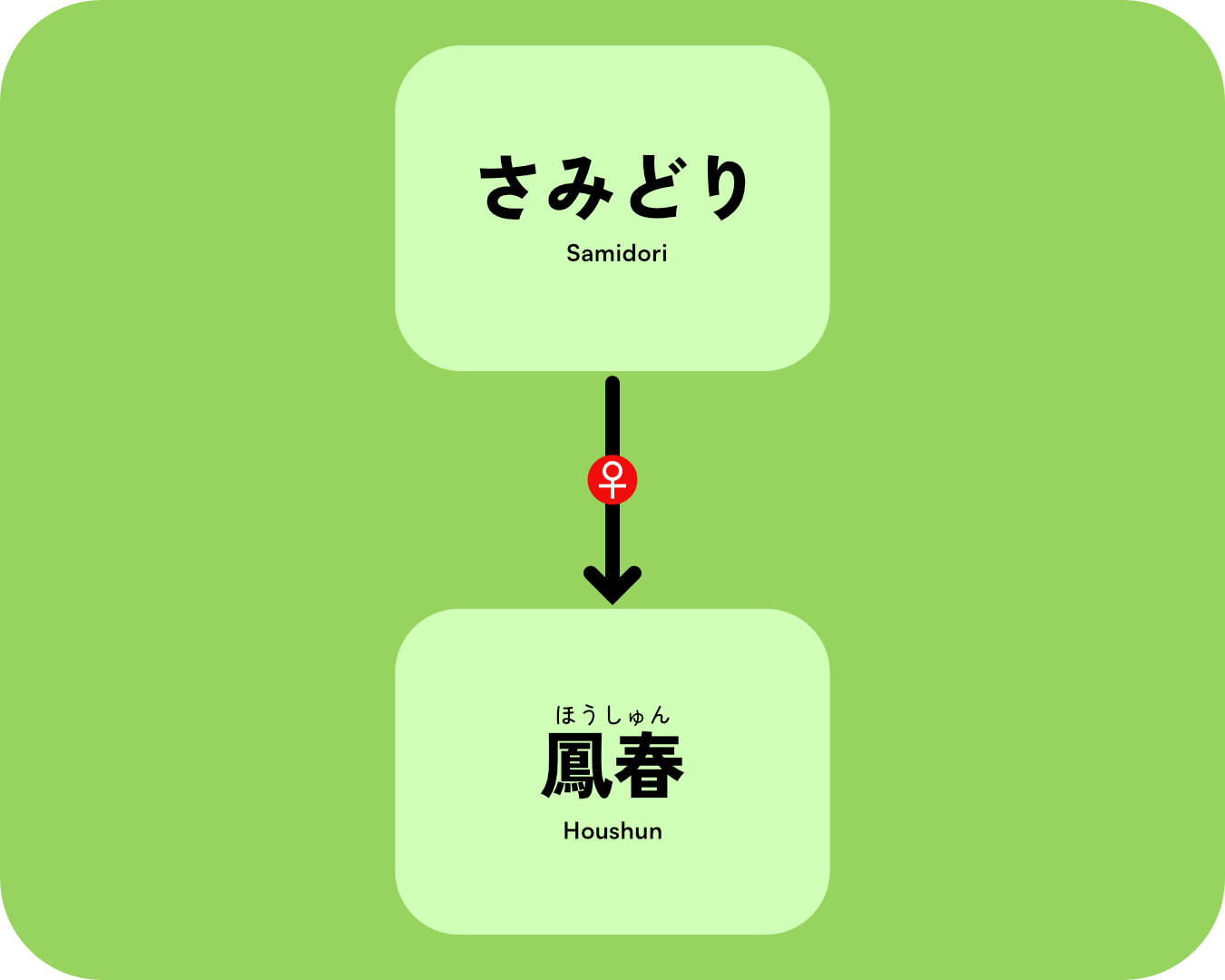Houshun 鳳春
The Hoshun cultivar suitable for Gyokuro was selected in 1977 from natural crosses of the Samidori cultivar in 1975 and registered in 2006. Breeding of the cultivar was done at ...

Status: 🌱
Genealogy
♀: Samidori さみどり
♂: ?

History
The Hoshun cultivar suitable for Gyokuro was selected in 1977 from natural crosses of the Samidori cultivar in 1975 and registered in 2006. Breeding of the cultivar was done at the Kyoto prefectural tea research centre alongside Tenmyo, selected and registered in the same years, also out from natural crossings of Samidori. Samidori is an unregistered cultivar selected out of Zairai (seed-grown) Kyoto prefecture tea bushes by Masajiro Koyama 小山政次郎 and then developed at the Kyoto prefectural tea research centre. Do not confuse with similarly sounding but different cultivars like Saemidori, Sakimidori or Sainomidori.
Although registered on the 4th of February 2004, it was not finally published and registered until the 14th of December 2006. Its strain number was 53-7 during the testing phase, and its registration number is 14534. The registration period is getting wider and wider for new cultivars, compared to the older cultivars, which usually were registered a couple of months after application. If you are interested in how the registration workflow works, you can find a document outlining the entire process here, which includes vegetables, cereals and other agricultural products.
The Kyoto Prefectural Tea Research Centre stresses in most of its documentation regarding tea crossbreeding and research its work to support the Uji tea brand, perhaps one of the most recognizable at the national and international level. Its research focuses on shaded teas like Tencha, the precursor of Matcha and Gyokuro, two of the most recognizable teas produced in the prefecture. It has developed many cultivars suited for shaded tea production and improvement in the processing methods as well. On crossbreeding of cultivars, although the centre developed several cultivars, many didn´t become registered but are used regardless inside the prefecture. Perhaps one of the reasons they are mostly found only inside the Kyoto prefecture and not in other prefectures. Some cultivars developed in this research centre include Asahi, Gokou, Ujimidori, Ujihikari, Samidori and Tenmyo.
There are others even less known. Florent from Japanese Tea Sommelier maintains a great resource with an extensive table listing some and others from all over Japan here.
Characteristics
Houshun is a cultivar suitable for Gyokuro, with an early budding and harvesting period. It allows for a better distribution of the workload for harvesting and processing. Being an early cultivar, it can also arrive earlier to market and thus sell for a higher price. Although today, there are also other early cultivars competing for those early spots in the market, so not only the timing of harvest will secure a higher price, but also the quality of it.
Houshun is a very early budding and harvesting cultivar, around seven days earlier than Samidori and ten days earlier than Yabukita. Harvest is, on average, four days earlier than Yabukita. Both harvest by hand picking and machine are higher than Samidori in the comparison data at 110% and 117%. The Hand-picking data is from bushes grown in the Shizen-shitate 自然仕立て or natural shape bush under a shelf-style shading structure, a style of growing common for Gyokuro and also for Tencha.
Since the budding period is early, thorough frost protection is necessary. When grown in the Une-shitate 畝仕立て, the characteristic arc-shaped pattern, the leaves tend to become a little smaller. Good trimming techniques and fertilization can help to prevent that. Disease resistance is strong against ring spot disease and moderate against anthracnose.
The Houshun bush is somewhat upright, with many branches and has good root strength. The new leaves are green, slightly larger and thicker than Samidori. The first harvest is as high as the Samidori, and so is the amount of buds. It has a strong aroma, freshness and other sought-after flavours for Gyokuro production. Its leaf lustre tends to be light-coloured, but its shape is narrow and curly, and it rolls easily. The chemical components of amino acids and tannins are considered medium in concentration.
References
京都府. ‘新品種’鳳春(ほうしゅん)、展茗(てんみょう)’について’. 京都府, https://www.pref.kyoto.jp/chaken/seika_hou-ten.html. Accessed 24 Mar. 2024.
公益社団法人 静岡県茶業会議所. 茶の品種. 2019.
品種登録迅速化総合電子化システム. https://www.hinshu2.maff.go.jp/vips/cmm/apCMM112.aspx?TOUROKU_NO=14534&LANGUAGE=Japanese. Accessed 19 Mar. 2024.
Guide to cultivar registration MAFF https://www.maff.go.jp/j/shokusan/hinshu/info/tebiki/toroku_tebiki.pdf
Japaneseteainstructor, Florent-. ‘The Japanese Tea Cultivars’. Japanese Tea Sommelier, 22 Aug. 2022, https://japaneseteasommelier.wordpress.com/2022/08/22/the-japanese-tea-cultivars/.
